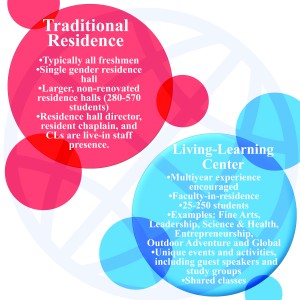 By Maleesa Johnson
By Maleesa Johnson
Staff Writer
Living-learning programs are proving to help students succeed academically in addition to providing them with a close-knit community,
“When you actually put like-minded people in the same place to live, chances are they’re going to strike a friendship and they’ll help each other succeed,” said Dr. Rizalia Klausmeyer, director of the Science and Health LLC. “That’s the hope that we have.”
The addition of East Village Residential Community is one example of the growth of living-learning programs. LLPs consist of undergraduate students who live together in a section of the hall or of the entire hall and are part of an academic or co-curricular program.
In “Why Baylor has Living-Learning Programs,” a study done by Dr. Jeff Doyle who is the dean for student learning and engagement, he states that living-learning programs are one of the best ways to do residential community in college.
Most residence halls with living-learning programs have additional study spaces, classrooms, faculty offices, a library, a reflection or chapel space and a conference room. According to Doyle’s study, this is meant to encourage learning and faith development among residents.
These programs at Baylor have been included in national studies. These studies show that LLP students in comparison with non-LLP students are more likely to be academically successful.
“It has been proven that students that are in LLPs that have the same interests, tend to have a higher GPA,” Klausmeyer said. “That would be incredibly beneficial for us because we’re also in pre-health, so the majority of our students are going to want to get into medical, dental, vet or physical therapy school. So they’re going to have a small advantage, or hopefully a big advantage. But we cannot judge yet since this is our second month.”
In accordance with the national study, studies from the Institutional Research and Testing at Baylor show that freshmen living in living-learning Communities and residential colleges are more likely to remain at Baylor.
Klausmeyer said Baylor would like students of all classifications to live on campus.
“That’s what the university wants,” Klausmeyer said. “We’re moving towards having the majority of students living on campus, which would be a benefit for all of us. The freshmen students especially, when they actually have contact with upperclassmen, can see and ask questions on how they do it and what to do to be successful.”
The study conducted by Doyle also shows a comparative analysis made by the Educational Benchmark Inc. in partnership with Baylor. This compared LLP and non-LLP students.
The results included positive responses from LLP students with regard to interaction with faculty and the ability to study in their room. Overall, LLP students believed that living on campus helped them study more effectively.
The assistant program director for Brooks College, graduate student Melissa McLevain, attended Georgetown College in Kentucky.
The student body was smaller, but McLevain said Baylor’s programs help build the same communal feeling of a smaller school.
“One of the things I really loved about Georgetown was how small and residential it was, but of course that was a lot easier at a school with only 1,200 students,” McLevain said. “At Baylor, it’s 12-15 thousand students. It’s really unique and really cool whenever they can create environments that make that same sense of community in such a large school.”
The current renovation of South Russell Residence Hall and the plans to refurbish North Russell Residence Hall mark a transition in the style of residencies at Baylor. Previously, these halls were traditional halls, aimed specifically for freshman females.
Though no specific program has been chosen for the halls yet, Doyle said they want to provide communities that embody that of a living-learning program.




